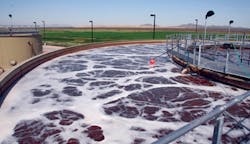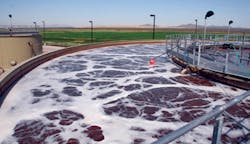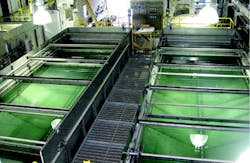ByArt Haddaway, Industrial WaterWorld Staff
If you've been in the water or wastewater field long enough, you know that most companies -- from the oil and gas industry to the food and beverage business -- use a significant amount of water to operate their facilities.
Industrial sectors worldwide consume approximately 20 percent of fresh water, although it varies between regions and countries, according to the United Nations World Water Development Report, and utilities within the U.S. consume over 50 percent of water, according to myhydros.org. Manufacturers use water for everything from harnessing energy to cleaning equipment to producing a product, but many of them consume the resource more than they conserve it.
However, water has rapidly changed from merely a convenience to one of the most dependable means of sustainability within the industrial sector. But as a result, many factors often go overlooked when it comes to conserving our most precious resource of all.
"Conserving water includes reducing the time and volume of water used for each task, analyzing all water requirements to recycle and reuse wherever possible and also filtering and purifying for recycling and reusing instead of relying on potable water sources," said Dan Theobald, owner of Environmental Services, a wastewater training and safety consulting business.
It's arguable that a lack of water conservation as a whole can be primarily attributed to a lack of water stewardship within the walls of each facility itself. From the purchase of water to its usage and treatment to its cooling and discharge, the process by which water is used in every sphere of production significantly affects the quality and extent to which water is conserved.
"If for example a manufacturer uses a relatively small volume of water, the incentive to conserve may be virtually nonexistent," Theobald said. However, a manufacturer requiring a large volume of water may execute procedures conserving approximately 20 percent of a 740,000 gallon daily water use with examples such as recycling water used to cool pumps, using the same water for multiple days, limiting water use during sanitation with flow restrictors and timers, and whenever possible performing a task without the use of water.
Theobald helps a variety of industries identify areas where they can conserve water by outlining water requirements, reducing costs and improving water treatment -- all of which work simultaneously. This typically includes facilities that rely on water to generate a product for the sake of profit. One archetypal example is the food and beverage business.
Theobald described how one particular food processing plant he worked with saved over 150,000 gallons of water at a cost savings of about $100,000 by utilizing a variety of essential but simplified strategies that he has employed in numerous facilities nationwide.
"Typically wherever you've got cost inefficiencies or operating inefficiencies, you've also got treatment results inefficiencies, and when you identify those inefficiencies, the improvements go hand in hand," Theobald said. "You improve the quality of treatment and you reduce the cost of the operation."
Theobald said for this processing plant, the quickest way to get a big reduction in water usage was to optimize the cooling system.
"We were using city water to cool pumps and then sending it down the drain to wastewater," he said. "We recognized that we could take that water, capture it, and pump it back into the supply - for cooling water and cooling towers and general reuse."
Theobald also found conservation opportunities in the company's sanitation department by cleaning the facility using less to no water while still carrying out the same job, primarily by restricting the flow rates of most of the cleaning hoses.
"That's huge because if you go into some of these food plants and you actually look at what's going on, a tremendous amount of water usage actually comes from a sanitary process, so if you can analyze the functions occurring in sanitation, you can really go a long way in reducing the amount of water consumed," Theobald said.
An internal reporting system was also installed to monitor the facility's water usage on a 24-hour basis and help control levels of intake and effluent according to the permit limits. The plant also saved around 30,000 gallons per day by changing the frequency of emptying cook tanks from daily to weekly.
"Food plants use a tremendous amount of water, so if you take what's going on in this food plant and you apply it to other food plants, you really do have a multiplier effect in the water cycle," Theobald said.
When it comes to water stewardship, soft drink giant PepsiCo is at the forefront of innovation with its successful and widely recognized conservation efforts, all the while striving to help industries -- from local to global -- do the same.
Last year, PepsiCo was awarded the 2012 U.S. Water Prize by the U.S. Water Alliance for its water and environmental stewardship endeavors applied at its Frito-Lay snack facility in Casa Grande, Ariz.
"We tried and executed a project to take one of our manufacturing plants as far off the grid as possible in order to really set for us and for PepsiCo a standard on environmental sustainability and a standard on energy and water efficiency at one of our manufacturing plants," said Al Halvorsen, Director of Environmental Sustainability at Frito-Lay.
PepsiCo implemented a design that included a membrane bioreactor, activated carbon, low-pressure reverse osmosis, ultraviolet light and chlorine disinfection that reduced the amount of water discharged from the plant by 75 percent.
"For us, it falls under that ‘Performance with Purpose' mission of making sure we have performance at all times so that we have a purpose behind it," Halvorsen said. "We want to make sure we are on the leading edge of water stewardship as a company in order to ensure that we have enough water for the communities we operate in, and also for our products, especially in the agricultural fields."
"It's very important for everybody to look at water," he said. "And as you look at the impact that water has and the availability of water up and down the supply chain -- whether it's from the seed all the way to the store shelves -- it's very critical," he added.
Every industry is different, but the overall concept of water conservation is universal: to perform the same job, producing the same results, using less water.
Businesses that have instituted a form of water conservation have proven to experience a reduction in their water costs, increased benefits to the environment, efficiency in energy and an overall improvement to their productivity. But when it comes down to it, conserving water just makes good business sense.
"The solution is going to depend upon whatever the usage of the applications is, so the solutions in one industry might be a little different then the solutions in another industry," Theobald said.
"The first thing you're going to do is analyze your water requirements," he continued. "You're going to look to see where you're using water, how much water you're using, and what the quality of those water requirements are. Then you're going to see if there are opportunities for you to decrease."
Ultimately, the key to resolving water wastefulness rests in the hands of each facility identifying where waste is occurring and implementing an effective strategy to save water in every aspect of its operation.




